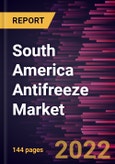Bio-based antifreeze is formed with biodegradable and renewable base stocks. Being biodegradable, it is mostly used in end-use industries such as automotive, industrial heating, and manufacturing. Bio-based antifreeze is produced from renewable and sustainable substitutes of raw materials compared to conventional chemical-based antifreeze. Bio-based antifreeze also helps reduce carbon footprint. Further, bio-based antifreeze provides better lubrication and has superior viscosity performance. It also provides good thin film strength, low volatility, and high flash point. Bio-based antifreeze always has a high degree of lubricity to reduce friction when used in construction equipment or the automotive industry. This reduced friction results in lower cutting forces, less heat generation during metalworking, and faster tool feed. Reduced friction reduces wear and extends the life of grinding wheels and cutting tools. In addition to the above factors, bio-based antifreeze lubrications have a much higher flash point than oils, resulting in higher feed rates and lower smoke, and less smoky metal cutting environments. These oils also have a more polar attraction to metals than petroleum-based fluids, which are nonpolar to metals. The polarity of the bio-based antifreeze lubricant provides more effective thin film protection and metal affinity for the cutting tool equipment. Prominent and well-established market players are launching innovative bio-based antifreeze products. They are launching innovative and environment-friendly liquid coolants, such as biodegradable coolants and natural antifreeze, providing performance advantages, low viscosity, and high corrosion protection. Furthermore, companies are constantly testing new-coolant technologies that are less costly than conventional propylene glycol and can improve the working environment for operators. All these factors are creating lucrative opportunities for bio-based and environment-friendly antifreeze coolants.
Market Overview
The SAM antifreeze market comprises of Brazil, Argentina, and rest of SAM. Growing vehicles in operation and increased miles travelled per year is estimated to drive the demand for antifreeze market. Moreover, the increased sales of passenger cars due to the improved standard of living and per capita income in the region is also contributing to the market growth. Additionally, antifreeze provides higher thermal capacity, non-toxic, anti-corrosive and low viscosity properties that make it fit for several heating, ventilation, and air conditioning (HVAC) applications. Furthermore, automotive maintenance and service providers are focused on providing automotive lubricants along with antifreeze services to generate more revenue, which, in turn, is expected to have a positive impact on the growth of the antifreeze market. Several global OEMs are investing in the country either through joint ventures with established players or after the relaxations of FDI norms, investing directly in setting up their own production units or enhancing the sales and dealership networks across the country. With the growing investments in the automotive sector, the production of automobiles in the country is expected to drive the antifreeze market.SAM Antifreeze Market Segmentation
The SAM antifreeze market is segmented based on coolant type, technology, application, distribution channel, and country. -Based on coolant type, the SAM antifreeze market is segmented into ethylene glycol, propylene glycol, and glycerin and others. The ethylene glycol segment held the largest market share in 2022.- Based on technology, the SAM antifreeze market is segmented into inorganic additive technology, organic acid technology, and hybrid organic acid technology and others. The organic acid technology segment held the largest market share in 2022.
- Based on application, the SAM antifreeze market is segmented into automobiles, industrial heating/cooling, energy, and manufacturing and others. The automobiles segment held the largest market share in 2022.
- Based on distribution channel, the SAM antifreeze market is segmented into original equipment manufacturers (OEMs), aftermarket, and retail and others. The aftermarket segment held the largest market share in 2022.
- Based on country, the SAM antifreeze market has been categorized into Brazil, Argentina, and rest of SAM. Our regional analysis states that Brazil dominated the market share in 2022. BASF SE, CCI Corporation, Chevron Corporation, Dow Inc., Exxon Mobil Corporation, Old World Industries, Prestone Products Corporation, Shell plc, Valvoline LLC, and Wacker Chemie AG are the leading companies operating in the SAM antifreeze market.
Table of Contents
Companies Mentioned
- Basf Se
- Cci Corporation
- Chevron Corporation
- Dow Inc.
- Exxon Mobil Corporation
- Old World Industries
- Prestone Products Corporation
- Shell Plc
- Valvoline Llc
- Wacker Chemie Ag
Table Information
| Report Attribute | Details |
|---|---|
| No. of Pages | 144 |
| Published | November 2022 |
| Forecast Period | 2022 - 2028 |
| Estimated Market Value ( $ | $ 400.16 Million |
| Forecasted Market Value ( $ | $ 519.51 Million |
| Compound Annual Growth Rate | 4.4% |
| No. of Companies Mentioned | 10 |








